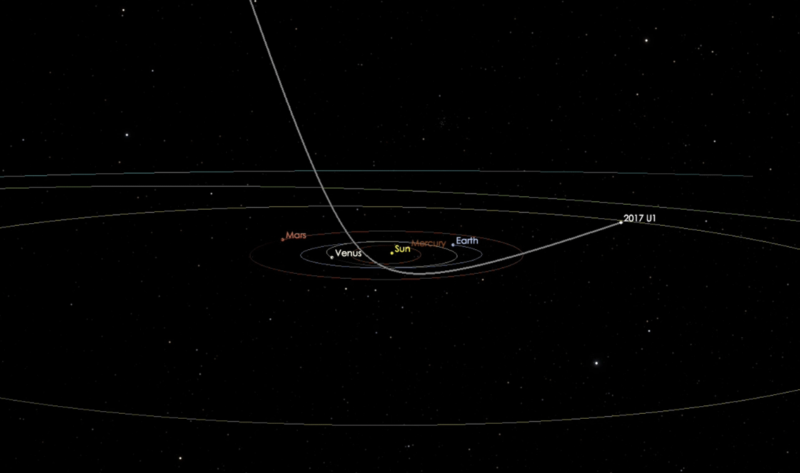
Last year, the Solar System was treated to its first known tourist. 'Oumuamua, an odd, cigar-shaped body, shot through our neighborhood at high speed, following an orbit that indicates it arrived from somewhere else. Although bodies ejected from other solar systems are expected to make regular visits, this was the first one that we'd imaged sufficiently to determine that its origins were elsewhere.
The imaging, however, didn't resolve a somewhat different debate: what, exactly, is 'Oumuamua? Its odd orbit had initially had it categorized as a comet, as these tend to have more extreme orbits. But imaging didn't show any indication of gas and dust being released, as is typical when a comet approaches the Sun. That imaging also revealed that it had an elongated, cigar-like shape. Combined with its relatively rapid rotation, this would indicate that 'Oumuamua had to be fairly robust, leading to the conclusion that it was probably an asteroid.
But now, a large international team of researchers is weighing in with another vote for comet. The argument, says the team, is based on the odd behavior of 'Oumuamua, which appears to have been accelerating away from the Sun.
Gravity not enough
The new analysis is based on the fact that shortly after the body was recognized as likely to be a visitor from another solar system (or "exosolar system"), many telescopes were redirected to image it. Many of the images were of sufficient quality to provide positional information on 'Oumuamua. This let the researchers calculate the object's trajectory through the Solar System. From there, it's a relatively simple matter to calculate if that trajectory was the result of purely gravitational interactions. Here, the researchers were cautious, including "gravitational forces due to the Sun, the eight planets, the Moon, Pluto, the 16 largest bodies in the asteroid main belt, and relativistic effects."
Based on these calculations, gravity comes up short. There are 10 measurements where 'Oumuamua was more than five standard deviations away from where it would be expected to have ended up based on gravity alone. Another 25 locations are more than three standard deviations off.
The researchers then modeled an additional, non-gravitational effect based on 'Oumuamua's distance from the Sun. If the Sun was having an additional influence on its motion, then this should be able to compensate for it. It worked, in that an additional acceleration based on distance from the Sun could get 'Oumuamua's calculated motion to better match the observations. Quite a bit better, in fact, as the authors say that their modified equation "corresponds to a formal detection of non-gravitational acceleration with a significance of about 30σ." Typically, only five sigma is needed to call something a discovery.
But that doesn't tell us what's generating this additional acceleration. The researchers consider a large list of possible causes: warming-induced release of gas from 'Oumuamua, solar-radiation pressure, something called the Yarkovsky effect, friction-like effects, a single change in velocity due to a collision, 'Oumuamua being more than one fragment rather than a single body, the influence of irregular surface brightness, and 'Oumuamua having a high magnetic field.
Process of elimination
Most of these explanations are pretty unlikely. Solar radiation pressure could only cause enough acceleration if 'Oumuamua were exceptionally light, about 1,000 times less dense than a typical asteroid. There's a similar problem with an acceleration caused by 'Oumuamua radiating away heat (the Yarkovsky effect) or having the radiation pressure be off-axis due to differences in the body's surface brightness. There's no indication that 'Oumuamua is fragmented in any images, while the jolt of a collision doesn't fit the data as well as a consistent force. Small bodies don't have a large enough magnetic field to create this much force.
In the end, warming-induced gas release is the least-worst of the possible explanations. It should generate a consistent force and one that scales with proximity to the Sun, which is what seems to be happening. But it also requires that 'Oumuamua be fairly comet-like, which is inconsistent with its shape and rotation. Plus there's the fact that we didn't see any signs of outgassing, like a plume of dust or the spectral signature of gasses.
As far as directly detecting gasses, the researchers estimate that the amount of water released could be below detection limits while still producing enough force. But comets from our own Solar System also release another chemical with the water, and that should have been detected. Of course, it's possible that coming from a different solar system means that 'Oumuamua has a different chemical composition. The dust ejected along with the gas should also have been detected if it's typical of comets we've imaged before, but the dust could escape detection if its grains are sufficiently large.
Unfortunately, 'Oumuamua is now long past the point where further imaging could help clarify any of these issues. But that won't stop astronomers from arguing over the data we do have, and the new paper adds some significant points that will have to be part of any future arguments.
Nature, 2017. DOI: 10.1038/s41586-018-0254-4 (About DOIs).
https://arstechnica.com/science/2018/06/visitor-from-another-solar-system-may-have-been-a-comet/Bagikan Berita Ini














0 Response to "Visitor from another solar system accelerated away from the Sun"
Post a Comment